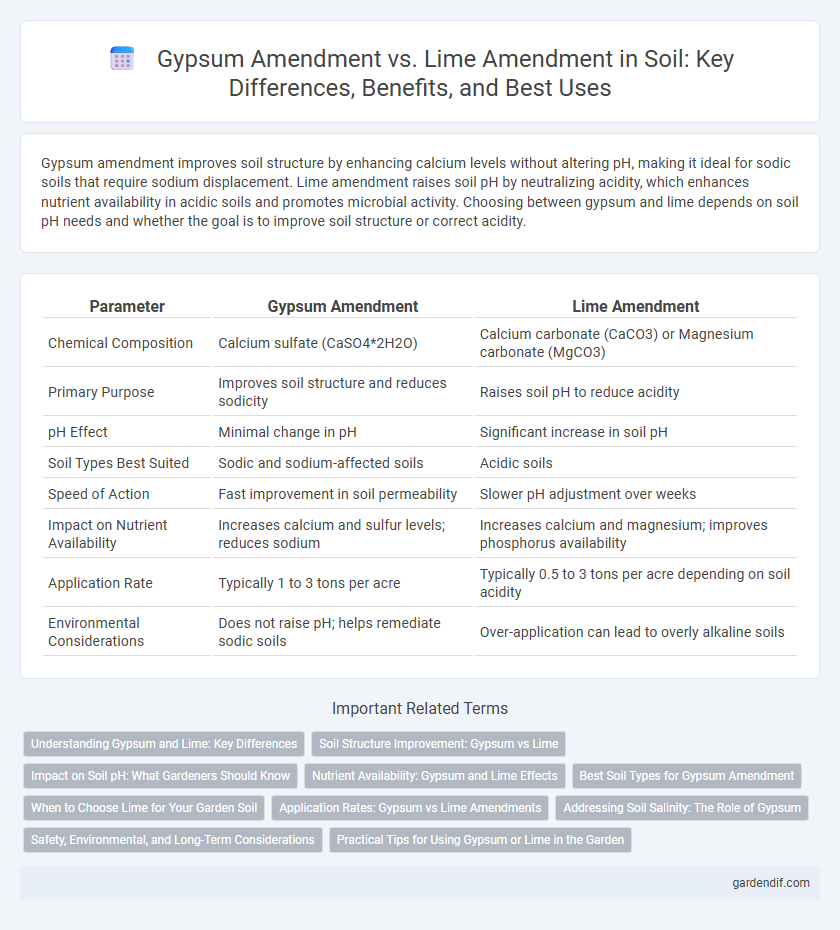
Gypsum amendment vs Lime amendment Illustration
Gypsum amendment improves soil structure by enhancing calcium levels without altering pH, making it ideal for sodic soils that require sodium displacement. Lime amendment raises soil pH by neutralizing acidity, which enhances nutrient availability in acidic soils and promotes microbial activity. Choosing between gypsum and lime depends on soil pH needs and whether the goal is to improve soil structure or correct acidity.
Table of Comparison
| Parameter | Gypsum Amendment | Lime Amendment |
|---|---|---|
| Chemical Composition | Calcium sulfate (CaSO4*2H2O) | Calcium carbonate (CaCO3) or Magnesium carbonate (MgCO3) |
| Primary Purpose | Improves soil structure and reduces sodicity | Raises soil pH to reduce acidity |
| pH Effect | Minimal change in pH | Significant increase in soil pH |
| Soil Types Best Suited | Sodic and sodium-affected soils | Acidic soils |
| Speed of Action | Fast improvement in soil permeability | Slower pH adjustment over weeks |
| Impact on Nutrient Availability | Increases calcium and sulfur levels; reduces sodium | Increases calcium and magnesium; improves phosphorus availability |
| Application Rate | Typically 1 to 3 tons per acre | Typically 0.5 to 3 tons per acre depending on soil acidity |
| Environmental Considerations | Does not raise pH; helps remediate sodic soils | Over-application can lead to overly alkaline soils |
Understanding Gypsum and Lime: Key Differences
Gypsum amendment primarily supplies calcium and sulfur to improve soil structure and alleviate aluminum toxicity without significantly altering soil pH, making it ideal for sodic soils. Lime amendment mainly raises soil pH by neutralizing acidity, providing calcium and magnesium essential for nutrient availability and microbial activity. Understanding these distinctions helps optimize soil health by selecting gypsum for improving soil physical properties and lime for correcting soil acidity.
Soil Structure Improvement: Gypsum vs Lime
Gypsum improves soil structure primarily by supplying calcium without raising pH, which enhances soil aggregation and reduces surface crusting in sodic or saline soils. Lime amendment raises soil pH while providing calcium and magnesium, effectively improving nutrient availability and microbial activity in acidic soils but may cause soil compaction if overapplied. Gypsum is preferred for sodic soil reclamation due to its ability to displace sodium ions, whereas lime is ideal for neutralizing soil acidity and improving overall soil tilth.
Impact on Soil pH: What Gardeners Should Know
Gypsum amendment primarily improves soil structure and calcium content without significantly altering soil pH, making it ideal for soils with adequate pH but poor physical properties. Lime amendment raises soil pH by neutralizing acidity, beneficial for acidic soils requiring pH adjustment to optimize nutrient availability. Gardeners should choose gypsum for calcium enrichment without pH change and lime to correct acidic soil conditions effectively.
Nutrient Availability: Gypsum and Lime Effects
Gypsum amendment improves nutrient availability by supplying calcium and sulfur without altering soil pH, enhancing calcium mobility and reducing aluminum toxicity in acidic soils. Lime amendment raises soil pH, increasing nutrient solubility and microbial activity, which boosts phosphorus and nitrogen availability but may precipitate micronutrients like iron and manganese. Both amendments optimize nutrient dynamics differently depending on soil chemistry and crop requirements.
Best Soil Types for Gypsum Amendment
Gypsum amendment is most effective in clay-heavy, sodic, and saline soils where calcium deficiency and high sodium levels impair soil structure and plant growth. It improves soil permeability and aeration by displacing sodium ions, making it ideal for poorly draining, compacted soils with high pH values. Unlike lime, which primarily adjusts soil pH, gypsum revitalizes alkaline, dense soils without significantly altering pH, making it optimal for soils requiring calcium supplementation without pH modification.
When to Choose Lime for Your Garden Soil
Choose lime amendment for your garden soil when pH levels are below 6.0, indicating acidic conditions that inhibit nutrient availability. Lime effectively raises soil pH, improving calcium and magnesium content essential for plant growth. It is ideal for clay or compacted soils, enhancing soil structure and nutrient retention.
Application Rates: Gypsum vs Lime Amendments
Gypsum amendments are typically applied at rates of 1 to 4 tons per acre to improve soil structure and reduce aluminum toxicity without significantly altering soil pH. Lime amendments require lower application rates, generally 0.5 to 3 tons per acre, primarily to raise soil pH and increase calcium availability. Application rates for both depend on soil test results, targeting optimal calcium and magnesium levels while addressing specific soil constraints.
Addressing Soil Salinity: The Role of Gypsum
Gypsum amendment effectively addresses soil salinity by supplying calcium ions that displace sodium ions from soil particles, improving soil structure and permeability. Unlike lime, which primarily adjusts soil pH, gypsum specifically targets sodic soils by reducing sodium-induced dispersion and enhancing water infiltration. This characteristic makes gypsum a preferred choice for reclaiming saline and sodic soils, promoting healthier plant growth and increased agricultural productivity.
Safety, Environmental, and Long-Term Considerations
Gypsum amendment improves soil structure and calcium levels without significantly altering pH, making it safer for acid-sensitive crops compared to lime, which raises pH and can cause nutrient imbalances if overapplied. Environmentally, gypsum's sulfate content aids in reducing aluminum toxicity and preventing soil erosion, while lime application risks increasing alkalinity and mobilizing heavy metals. Long-term, gypsum promotes soil permeability and sustained calcium availability, whereas repeated lime use can lead to soil compaction and diminished microbial activity.
Practical Tips for Using Gypsum or Lime in the Garden
Apply gypsum to improve soil structure in clay-heavy gardens where calcium is needed without altering pH, particularly to reduce soil compaction and enhance water infiltration. Use lime to raise soil pH in acidic soils, promoting nutrient availability for most garden plants, with a typical application rate of 5 to 10 pounds per 100 square feet based on soil test results. Always perform a soil test before application and evenly distribute the amendment, watering thoroughly to ensure effective absorption and prevent nutrient lockout.
Gypsum amendment vs Lime amendment Infographic

 gardendif.com
gardendif.com